| |
Field trip
day-2
Bükk-Szarvaskõ area
(Tardos quarry,
Tóbérc quarry, Új-határ valley, Szarvaskõ-pillow
basalts)
29.11.2003
Introduction
On
the second day of our field trip, we visited some interesting localities
of the Szarvaskõ complex, which is situated in the southwestern
part of the Bükk Mountains north of the city Eger.

Geology
of the Szarvaskõ area
This igneous
body consists mainly of a differentiated basalt-gabbro association with
few ultramafic rocks and plagiogranites intruded into terrigenous sediments.
These sediments are chiefly sandstones, shales, or siltstones.
This complex has always been a subject of debates and there still are
some questions which haven't been answered for sure.
One of these important, but difficult questions was the age of the complex,
which seems to be cleared up know. The early researchers suggested that
the complex was formed during the Cretaceous period (Schréter,1943;
Szentpétery, 1953) , and this conception has dominated for years.
After proving the Triassic age of the igneous rocks in the Eastern Bükk
area, most of the authors correlated the Szarvaskõ complex with
these igneous rocks and they considered it to be also Triassic by age.
The Triassic age has been confirmed many times (Földessy, 1975;
Balla et al., 1980; )
The first article which suggested a Jurassic age was by Balogh et al.
(1984), who related Jurassic radiolarians to the Szarvaskõ complex.
This hypothesis was proved by some K-Ar age determinations, which gave
an avarage age of 166 Ma, thus the complex is know considered to be
undoubtedly Jurassic by age.
 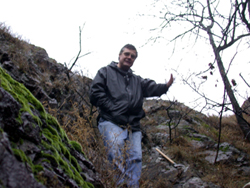
Pillow basalts
at Szarvaskõ (left) and the best specialist of Szarvaskõ:
Prof. Friedrich Koller
Another
difficult, and until know not solved question is the origin, the petrogenesis
of the complex. But to understand the possibilities, first of all let
us have a look at the types of the igneous rocks. The most detailed
study of the rocks was made by Szentpétery (1923, 1943, 1953),
who has described a wide variety of differentiation products.
Within the volcanic rocks, most abundant are the pillow basalts. The
plutonic section is mostly made up of gabbroic rocks with lots of differentiation
products. They are also varying in grainsize, from fine-grained up to
coarse-grained, and pegmatitic types. Interesting plutonic rocks are
the so called "plagiogranites", leucocratic rocks consisting
mostly of plagioclase and quartz, but it very often also contains garnet,
which is almandine-rich. From the most abundant gabbros there are transition
rocks to the ultramafics. These can be called pyroxenemelagabbros, gabbro-hornblendites,
peridotit-hornblendites etc.
The most famous ultramafic rock in this area is the Ti-rich ore peridotite,
which is better known as "wherlite" in the literature. This
name was given after Wehrle, who analyzed this rock the first time.
The most important ore-minerals are ilmenite, magnetite and titanomagnetite
which give an avarage ore-content of 25 % to this rock.
To sum up all, at first sight we can see that this complex was a result
of intruding magmas which went through differntiation processes. The
dominance of pillow-basalts show us (in agreement with the surrounding
deep-water sediments) that this intrusion must have taken place in marine
environment.
Like we
mentioned it before, the origin of this complex with its igneous rocks
is a very embarrassing and difficult question, and despite of the newest
analyzes on petrology and geochemistry, it remains a subject of guessing.
On our fieldtrip we where accompanied by Prof. Friedrich Koller from
Vienna, who has done lot of work on the Szarvaskõ area. One of
his students, Aigner-Torres has done the latest geochemical examination
on the complex (Aigner-Torres, 1996)
Among the conceptions we will just introduce the recently most supported
idea, which has been confirmed also by Prof. Koller and his student.
According to this model the igneous rocks of Szarvaskõ are fragments
of a dismembered ophiolitic sequence, thus remnants of Jurassic oceanic
lithosphere. This model was put forward by E.Szádeczky- Kardoss
(1974,1976), and it soon got the dominant model, wich most of the authors
supports with more or less modifications (Balla et al., 1980; Onuoha,
1977). If we believe this model, there still remains a question whether
if this ophiolit was located in an oceanic ridge or an other special
environment?
Recent studies on the paleotectonic of the region and geochemical analyzes
of the igneous rocks have shown that it is very likely that the ophiolite
was situated in a back-arc basin, and not an oceanic ridge (Aigner-Torres,
1996).
Even on our fieldtrip Prof. Koller introduced us this model, reminding
us also on the problems and unsolved questions concerning it.
Stop-1:
Tardos quarry
This quarry
is situated north of the village Szarvaskõ on the road to Mónosbél.
It is built up of different types of gabbros, which have a sharp contact
to each other. If we view the wall from distance, we can well separate
two types by colour, one is light, the other is much more darker. The
colours can be explained by the mineral-constitution: the darker one
is clinopyroxene-rich, and the lighter one contains much more plagioclase.
Between the gabbros there are also differences in grainsize; it varies
from fine- up to coarse-grained, but the real pegmatits-like those of
the Tóbérc quarry or the Újhatár valley-
are missing.
In this quarry also the surrounding sediments can be seen.
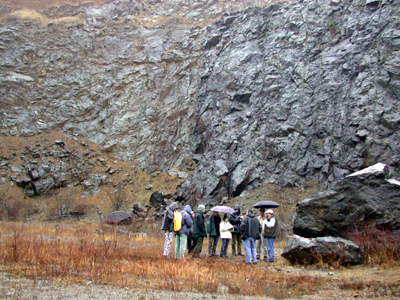
Tardosi
quarry, north from Szarvaskõ
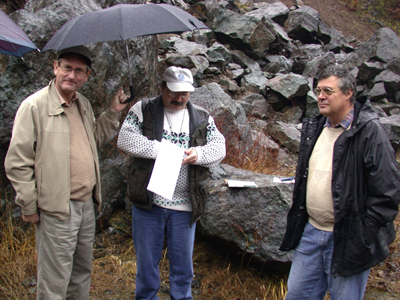
The guider
of the field trip: (right) Prof Friedrich Koller (University of Vienna),
(middle) Dr Molnár Ferenc (ELTE University Budapest, academic
sponsor of the SC, (left) Mr. Nigel Maund
Stop-2:
Pillow basalts at the Kétvíz hill
At the
crossing of the roads coming from Szarvaskõ to Mónosbél
and Tarnalelesz, there are some nice outcrops of pillow basalts. Intresting
in this locality is that here we don't find the common pillow structure
of many pillows settled on each other. Here we can see separate drops
of basalt within clayshale. The drops are really isolated from each
other, and surrounded by the clay, which is extremely burnt.
We consider that these drops where formed on a steep edge of a pillow
basalt field. When the lava tubes flow on the ground, reaching the edge
of the failure they fall down, and sank into the unconsolidated clay,
which was burnt by the hot drops.
It was very interesting for us to see this rare vulcanological phenomena.

Contact
metamorphised claystone at Kétvíz Hill
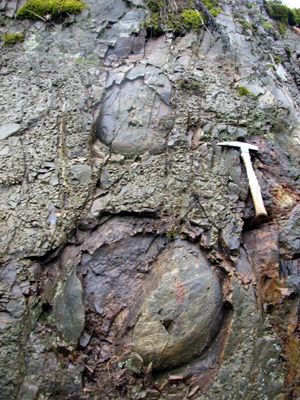
Contact
metamorphised claystone at Kétvíz Hill and separated pillow
basalt drops at Kétvíz Hill
Stop-3.
Pillow basalts at Várbérc Hill
If we walk out of the village Szarvaskõ a few hundred meters
on the road to Mónosbél, we get to a narrow canyon where
the hills on both sides break down with steep and rocky walls. These
are built up of lots of "pillows" settled on each other. To
tell the truth these forms not at all look like pillows, they much more
resemble tubes. They got their elongated forms by moving, flowing on
the ocean-bottom.
Between the pillows, at the triangular margin, the so called hyaloclastit
can be seen. When the lava flows out on the ground the edge of each
pillow gets glassy by the contact with water. Under cooling this edge
breaks up into pieces and falls down to these triangular spaces, where
it forms aquagene tuff, or hyaloclastit.
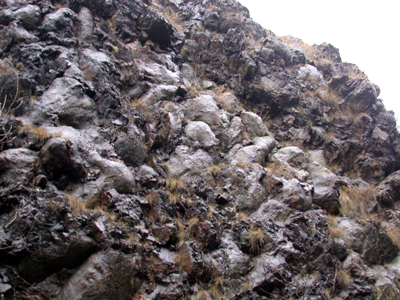
Pillow basalts
at Szarvaskõ on the Várbérc Hill
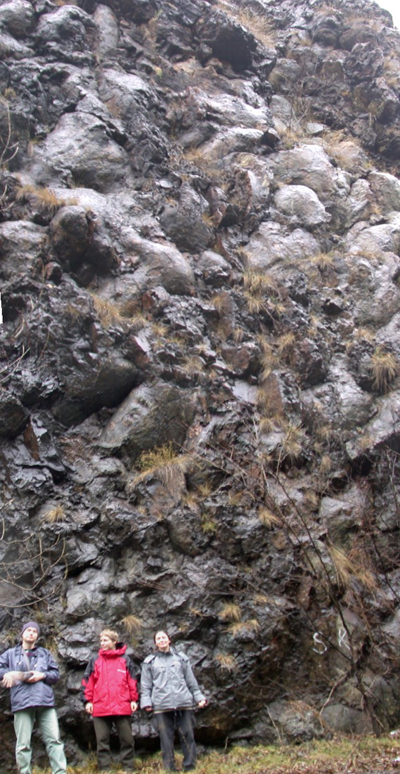
Pillow basalts
at Szarvaskõ on the Várbérc Hill
Stop-4:
Tóbérc (Forgalmi) quarry
The best
exposed are the plutonic rocks in this quarry, which is situated east
to the village Szarvaskõ at the entrance of the Újhatár
valley. Here most of the mafic plutonic differentiation products can
be found.
The gabbros dominate, but they can be very different in mineralogical
composition, and grainsize. Szentpétery (1923,1943,1953) has
separated many differentiation products on the basis of the common rock-forming
minerals. These minerals are the diallage-pyroxene, hypersthene, brown-amphibole,
biotite etc., thus the given rocknames are diallageamphibole-gabbro,
biotiteaugite-gabbro etc. The gabbros are mostly medium- and coarsegrained,
but the pegamtitic texture -with minerals up to 3-4 cm- is very common
to. These pegmatites are often near to the leucocratic rocks, collectivelly
termed as plagiogranites. These rocks are more acidic, contain much
plagioclase and quartz, and Szentpétery gave them also names
like biotitequartz-diorite, diallagegabbro-diorite. At the contact of
these rocks with the coarse-grained, or pegmatitic gabbro there often
appear garnets in an 1-2 cm thick zone.
It is likely that these leucocratic rocks, and the pegmatites where
formed by the contamination with the surrounding shales, and this process
caused the increased fluid-content, and acidity.
Not only
in this quarry, but in the hole igneous complex it can be established
that the rocks underwent a low pressure- low temparature (pumpellyite-prehnite
facies) metamorphism. This means that examining them with microscope
lots of secondary minerals can be found. Instead of pyroxene and amphibole
chlorite occurs, veins are filled with pumpellyite, prehnite.
Stop-5:
Outcrop in the Újhatár valley
This valley,
which ends at the Tóbérc quarry is built up by different
types of gabbros, but there are only few outcrops, because the brook
hasn't done big erosion, and there wasn't any quarrying in the valley
at all. Despite of this fact there is a very exciting outcrop at the
steep hill-side on the left shore of the brook, about 1 km inside the
valley. There are some rocks of gabbro which contain the most beautiful
pegmatites in the area. The pegmatites are mostly some decimetres in
diameter, and have different shapes. They can be elongated sills, and
tubes, or round, oval forms. In these pegmatites the amphiboles can
reach a length of 8-10 centimetres, and there also can be cavities with
grown-up crystals. The minaralogy of these pegmatites is under examination.
Epilogue
The financial background of our first Field Trip was estabilished by
the Student Chapter Field Trip Grant dominated by the Committee of Student
Chapters of the Society of Economic Geologists. We owe special thanks
to the SEG for supporting our programs and activity at Eötvös
Loránd University in the Carpatho-Panonian region. Our Academic
sponsor is sincerely ackowledged for providing an excellent guide and
understanding of the geology and mineral deposits of the Recsk and Szarvaskõ
area. The executive also thank the members for their contributions and
chearful attendance.
|
|








